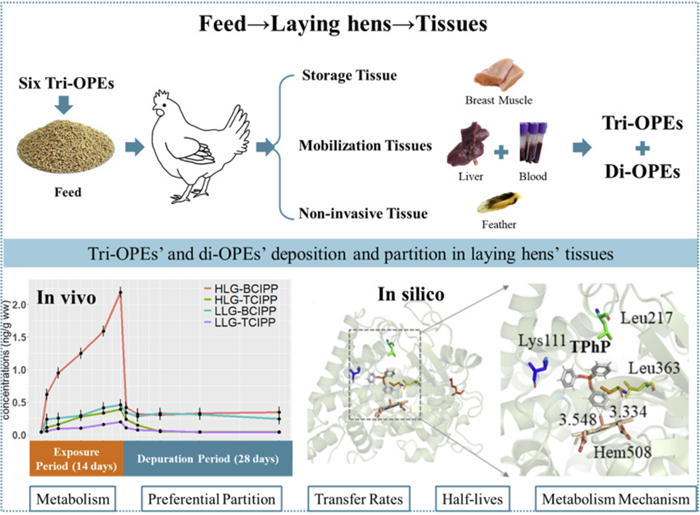New progress in the migration, transformation, and accumulation of emerging contaminants
Recently, the Institute of Quality Standards and Testing Technology for Agro-Products of the Chinese Academy of Agricultural Sciences has revealed the pollution characteristics and migration mechanisms of organophosphate esters (tri-OPEs) within farmed animals for the first time. The findings were published in the Journal of Hazardous Materials (IF=13.6).
Tri-OPEs are high-production chemicals globally, primarily used as flame retardants and plasticizers. They have attracted widespread concern due to their carcinogenic toxicity, endocrine disruption, and developmental and reproductive toxicity. With the increasing production and usage, they are now ubiquitous in air, soil, crops, and animal bodies. Feed exposure is a key pathway for the exposure and accumulation of tri-OPEs in farmed animals. Our preliminary studies have identified contamination of feed raw materials with tri-OPEs, suggesting that tri-OPEs are likely to migrate, accumulate, and transform through the food chain of farmed animals, persist in animal products, and ultimately pose human exposure risks. However, no studies have yet clarified the migration and transformation behaviors and mechanisms of tri-OPEs in farmed animals.
In this study, through a 14-day exposure and a 28-day elimination experiment involving 145 laying hens, we elucidated the bioaccumulation, distribution, and metabolic processes of tri-OPEs in farmed animals for the first time. Researchers of this study found that the concentrations of tri-OPEs and their metabolites, di-OPEs, in representative storage tissues (breast muscle), metabolic and transport tissues (liver and blood), and non-invasive tissues (feathers) increased during the exposure period and decreased during the elimination period, showing dose-dependent and time-dependent trends. The specific accumulation and rapid metabolism of aryl tri-OPEs in the liver was clarified using homology modeling, molecular docking, and quantum chemical calculation methods. The related mechanisms were mainly due to their higher binding affinity, lower reaction barriers, and dissociation energies, which favor targeted enrichment and metabolic capabilities compared to other tri-OPEs. Additionally, the use of feathers as an indicator tissue for avian exposure to tri-OPEs has been controversial. This study confirmed through a time-series investigation that feathers can reflect long-term exposure to tri-OPEs in birds, while short-term exposure is better indicated by their transformation products. This research provides important data support for assessing the behavior of tri-OPEs in farmed animals.
This work was supported by the National Natural Science Foundation of China and the National Key Research and Development Program of China.

Figure 1: ADME processes of OPEs and metabolites in laying hens
Link: https://doi.org/10.1016/j.jhazmat.2024.133598
By Li Xiaomin
(lixiaomin@caas.cn)
-
 Apr 28, 2024CAAS President Meets President of Murdoch University
Apr 28, 2024CAAS President Meets President of Murdoch University -
 Apr 18, 2024Opening Ceremony of the Training Workshop on Wheat Head Scab Resistance Breeding and Pest Control in Africa Held in CAAS
Apr 18, 2024Opening Ceremony of the Training Workshop on Wheat Head Scab Resistance Breeding and Pest Control in Africa Held in CAAS -
 Apr 03, 2024IPPCAAS Co-organized the Training Workshop on Management and Application of Biopesticides in Nepal
Apr 03, 2024IPPCAAS Co-organized the Training Workshop on Management and Application of Biopesticides in Nepal -
 Mar 28, 2024Delegation from the School of Agriculture and Food Science of University College Dublin, Ireland Visit to IAS, CAAS
Mar 28, 2024Delegation from the School of Agriculture and Food Science of University College Dublin, Ireland Visit to IAS, CAAS -
 Mar 25, 2024Director of World Food Prize Foundation visited GSCAAS
Mar 25, 2024Director of World Food Prize Foundation visited GSCAAS
